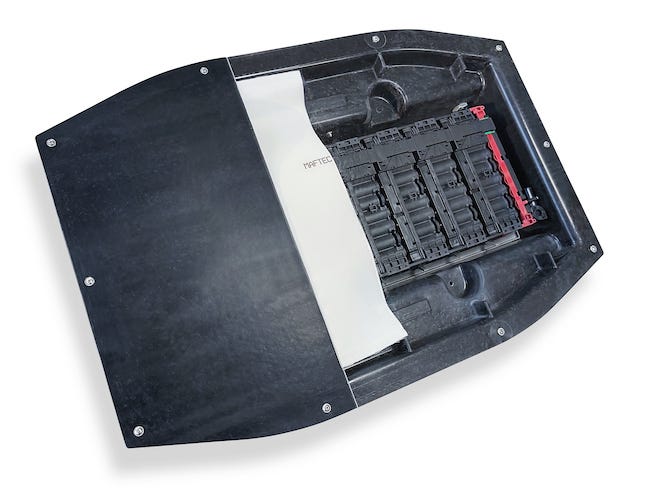How Mitsubishi Chemical Advances EV Lightweighting
The design of a composite EV battery enclosure also consolidated a five-part assembly into two parts.
September 13, 2023

Mitsubishi Chemical exhibited its latest innovation — an electric vehicle (EV) battery all-composite enclosure—as the centerpiece of its activities at The Battery Show North America in Novi, MI. The event, organized by Battery Technology's and PlasticsToday’s parent Informa Markets – Engineering, concluded on Sept. 14.
The partnered collaboration features Mitsubishi Chemical’s fiber-reinforced composite material portfolio for advanced energy storage systems, EDAG’s mobility engineering expertise, and Kreisel Electric’s specialized design and manufacturing capabilities for battery storage systems.
The latest design overcomes many of the concerns surrounding traditional EV battery enclosures. Typically, they are produced from heavy metallic profiles, which can have a negative impact on overall weight and vehicle performance. By switching to composite materials, the enclosure meets the requirements for EV battery housings while significantly reducing weight.
John Conn, engineering project manager at Mitsubishi Chemical Group, commented: “This is an exciting breakthrough that can make a real difference to the electric vehicle market, which is growing quickly as more people move to EVs. In addition to being extremely lightweight, the functional composite structure offers robust performance, high safety levels, and strong durability.”
Another key feature of the composite enclosure is part consolidation: This system has just two parts, compared with the initial EDAG design based on a metal housing comprising five parts. Downstream processes are simplified and costs are reduced. In addition, some components are recyclable and can include the use of recycled content, making for a product with higher circular economy credentials.
Various Mitsubishi Chemical composite materials are incorporated within the battery enclosure, including a flame-retardant fiber-reinforced thermoplastic material for the top cover that can withstand high-intensity thermal runaway events. The enclosure also incorporates an additional layer of insulative material made from Mitsubishi Chemical’s Maftec polycrystalline alumina fibers to further protect the battery cover.
|
The plastic composite EV battery housing developed by Mitsubishi Chemical and partners incorporates a layer of insulative material made from the company’s Maftec polycrystalline alumina fibers. |
The bottom tray was developed using two different materials — prepreg sandwich and carbon-fiber forged molding compound (CF FMC) — and produced using an innovative single process step to meet thermal, geometric, and structural requirements. In addition, Mitsubishi Chemical fabricated its own tooling and produced the assembly in-house, demonstrating an agile, vertically integrated value chain that can meet OEM requirements for bespoke solutions.
Designed by engineering services provider EDAG, the lightweight enclosure has been developed in collaboration with battery system manufacturer Kreisel Electric utilizing its patented immersion cooling technology.
“With more than 15,000 people expected to attend [The Battery Show], this is a tremendous opportunity to showcase what we have been striving for in partnership with EDAG and Kreisel,” commented Marcel Remp, mobility marketing manager at Mitsubishi Chemical. “One of the greatest concerns with electric vehicles in their current makeup is weight. By being able to reduce weight with a lighter battery enclosure, we are helping to make the transition to EVs and, thus, a more sustainable planet, more viable.”
About the Author(s)
You May Also Like




